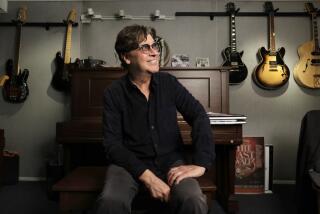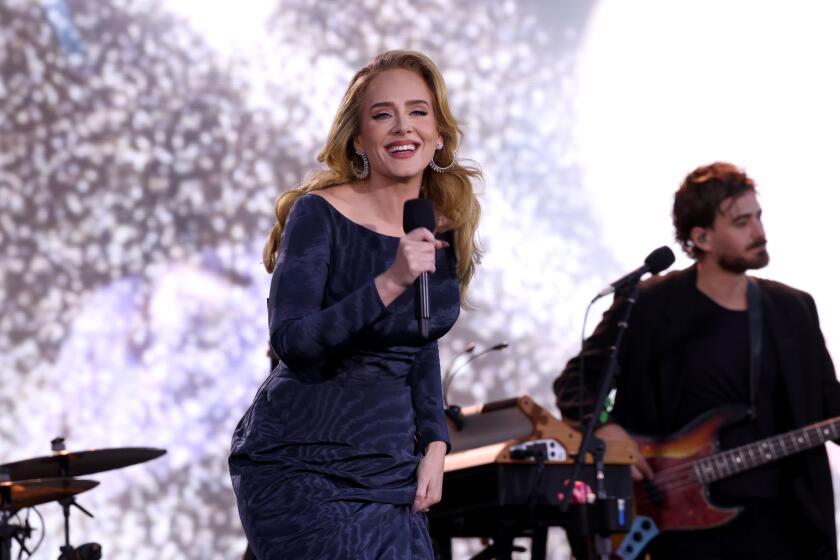Max Roach, 83; jazz drummer changed the face of percussion
Max Roach, a leader of the modern jazz revolution of the 1940s whose innovative approach to drumming forever changed the way the instrument was played and perceived, died Thursday. He was 83.
Roach died in a New York hospital, according to an announcement from Blue Note Records. No cause of death was given, but Roach was known to have been in failing health for some time.
His achievements reached well beyond his importance as a jazz drummer. He did not favor either word, in fact, believing that “jazz” and “drummer” diminished the creative and cultural significance of what the terms were intended to represent.
But his many accomplishments expanded the meanings of both. As a composer, Roach began from a jazz foundation and created a sequence of works expanding the vocabulary of contemporary composition.
As an instrumentalist, he brought the drum set to the front of the stage, making each element of the kit into a unique, individual instrument. No longer a roaring sound behind the horns, the drums -- after Roach -- became a musical source of infinite possibilities.
He was, in addition, a pioneer in the use of the creative arts for the advocacy of civil rights and racial equality.
Arriving on the jazz scene as a talented teenager in the early ‘40s, Roach was surrounded by a turbulent world of musical experimentation. Rhythm was a substantial element in the transformations taking place via the arrival of the powerful new jazz ideas that became known as bebop. Roach, inspired by the breakthrough drumming techniques of Kenny Clarke (a decade his senior), quickly began to add his own visionary methods to the fundamental methodology of jazz drumming.
In the process, the heavy-footed drive of the then-dominant swing style was converted to a lighter propulsion, in which the basic time-keeping of the beat was moved from the thump of the bass drum to the airy, ringing tone of a “ride” cymbal.
The change was liberating for drummers, allowing them to employ the bass drum for accents -- sometimes described (in those World War II years) as “dropping bombs” -- while encouraging the use of the full panoply of percussive effects within the standard drum kit.
From the time he made his recording debut with saxophonist Coleman Hawkins in 1944, Roach displayed a mastery of the new drumming while continuing to develop ways to use the freedom it afforded, effectively positioning himself as a cutting-edge member of the newly arriving bebop fraternity.
His style, with its urgent sense of swing, its mastery of brush and cymbal playing and its constant quest to establish drumming as an expression that moved beyond rhythm into rich and complex areas of melody and timbre, continued to evolve creatively for the balance of his long and vital presence as a jazz icon.
“Max,” said composer Quincy Jones on Thursday, “was one of the founders and original members of the A-Team of Bebop. He was also one of the first American musicians to understand the complex polyrhythms of Africa.”
Born in New Land, N.C., on Jan. 10, 1924, Roach moved with his family to Brooklyn when he was 4. Growing up, he sang in the choir of the Baptist church where his aunt was a pianist.
After briefly studying piano, he turned to the drums and was playing professional engagements while still attending Brooklyn’s Boys High School.
Roach was only 17 when he had the opportunity to temporarily fill in for drummer Sonny Greer with the Duke Ellington Orchestra.
“Most of the great drummers were in the Army,” he told The Times in 1991, “so when Sonny Greer got sick . . . I got the job because I could read music. . . . From that time on, everyone began calling me to make records -- Dizzy Gillespie, Henry Allen, Hot Lips Page. Whether I could play or not, they thought I could play because I’d been with the master.”
After performing and recording with the pioneers of the bebop movement -- Gillespie, Charlie Parker, Bud Powell, Miles Davis -- starting a record company (Debut) with Charles Mingus and participating in Davis’ influential “Birth of the Cool” sessions, Roach traveled to Los Angeles in 1953 to briefly replace Shelly Manne with the Lighthouse All-Stars.
A year later, he formed a quintet with trumpeter Clifford Brown, saxophonist Harold Land, pianist Richie Powell and bassist George Morrow.
The group’s tough-sounding blend of trumpet and tenor saxophone, urged forward by Roach’s dynamic drumming, became the vanguard sound of hard bop -- powerfully influential in the late 1950s and ‘60s and still a model for many contemporary jazz groups.
But the deaths of Brown and Powell in an automobile accident in 1956 effectively ended the group.
Roach was devastated but eventually returned to work with saxophonist Sonny Rollins (recording the classic “Saxophone Colossus”). His “Jazz in 3/4 Time” recording in 1957 was an early examination of the jazz potential of waltz rhythms.
In 1960, the recording of “We Insist: Freedom Now Suite” with Oscar Brown Jr., Coleman Hawkins and his then-wife Abbey Lincoln -- commissioned by the NAACP to celebrate the approaching 100th anniversary of the Emancipation Proclamation -- was a breakthrough sociopolitical statement for a jazz artist. As vital and transformative in its own fashion as Roach’s musical innovations of the ‘40s, it opened the way for jazz, and pop artists as well, to invest their music with meaningful commentary on the world around them.
“It all comes down to originality,” Roach told jazz critic Leonard Feather some years ago.
“There was one unforgettable night when I worked with Pres [Lester Young] at Birdland. Because I was with Pres, and because he and Papa Jo Jones were so close in the Basie band, I played all of Papa Jo’s old licks. At the end of the evening, after I said good night to Pres, he gave me one of those succinct lessons in that personal language of his. He said, ‘You can’t join the throng until you write your own song.’
“That’s a great lesson, something that stays with you the rest of your life; this music allows you, prefers you to be an individual, to do your own thing.”
Ever eager to expand his musical horizons, Roach -- who as a young man earned a degree in composition from the Manhattan School of Music -- began teaching at the University of Massachusetts in 1971, establishing a jazz major degree.
A few years later, he dipped into the avant-garde with pianist Cecil Taylor and alto saxophonist Anthony Braxton.
Other Roach ensembles included M’Boom, a 10-person all-percussion ensemble playing an extraordinary array of instruments from around the world; the Double Quartet, an ensemble consisting of the Max Roach Quartet and the Uptown String Quartet, led by his daughter, Maxine; and the So What Brass 5.
In 1983, again leading the way, Roach collaborated with MTV’s Fab Five Freddy on a performance piece combining jazz and rap. And his 1995 dance, music and reading recital with choreographer Bill T. Jones and novelist Toni Morrison was an extraordinary combination of the work of three highly honored African American artists.
He also composed for choreographer Alvin Ailey and scored plays by Shakespeare, Eugene O’Neill, Amiri Baraka and Sam Shepard, winning an Obie Award in 1985 for his work with Shepard. And he performed with the Japanese percussion group Kodo and the Cuban jazz group Irakere.
Roach was awarded a MacArthur Foundation “genius grant” in 1988, the first jazz artist to receive the honor.
He was inducted into the Grammy Hall of Fame for his Massey Hall recording on Debut Records with Parker, Gillespie, Powell and Mingus. He received an NEA Jazz Masters award, a Commander of Arts and Letters award from the French government and several honorary doctorates.
Roach’s survivors include his sons, Daryl and Raoul; and his daughters, Maxine, Ayl and Dara. Funeral arrangements were incomplete.
More to Read
The biggest entertainment stories
Get our big stories about Hollywood, film, television, music, arts, culture and more right in your inbox as soon as they publish.
You may occasionally receive promotional content from the Los Angeles Times.










